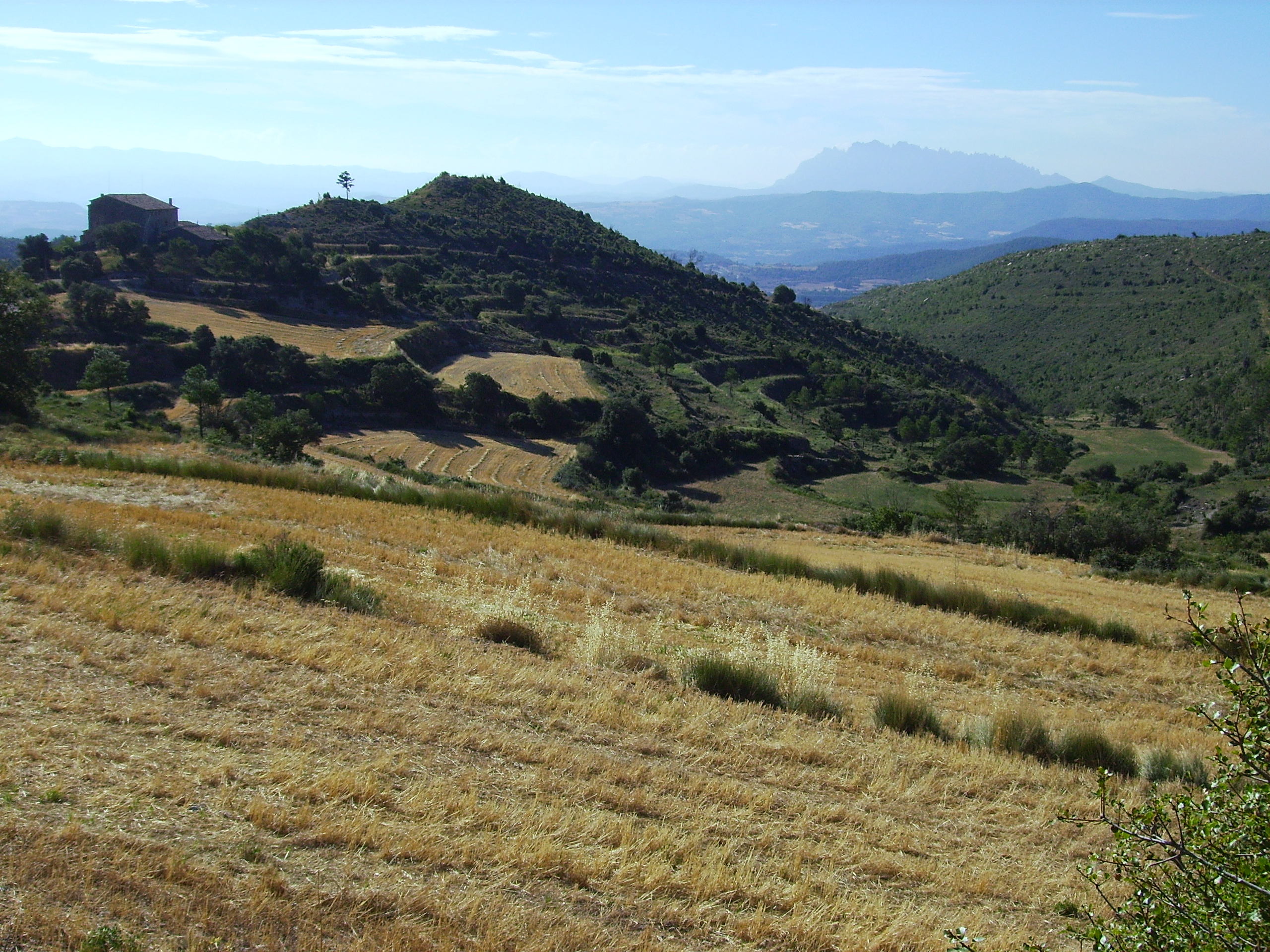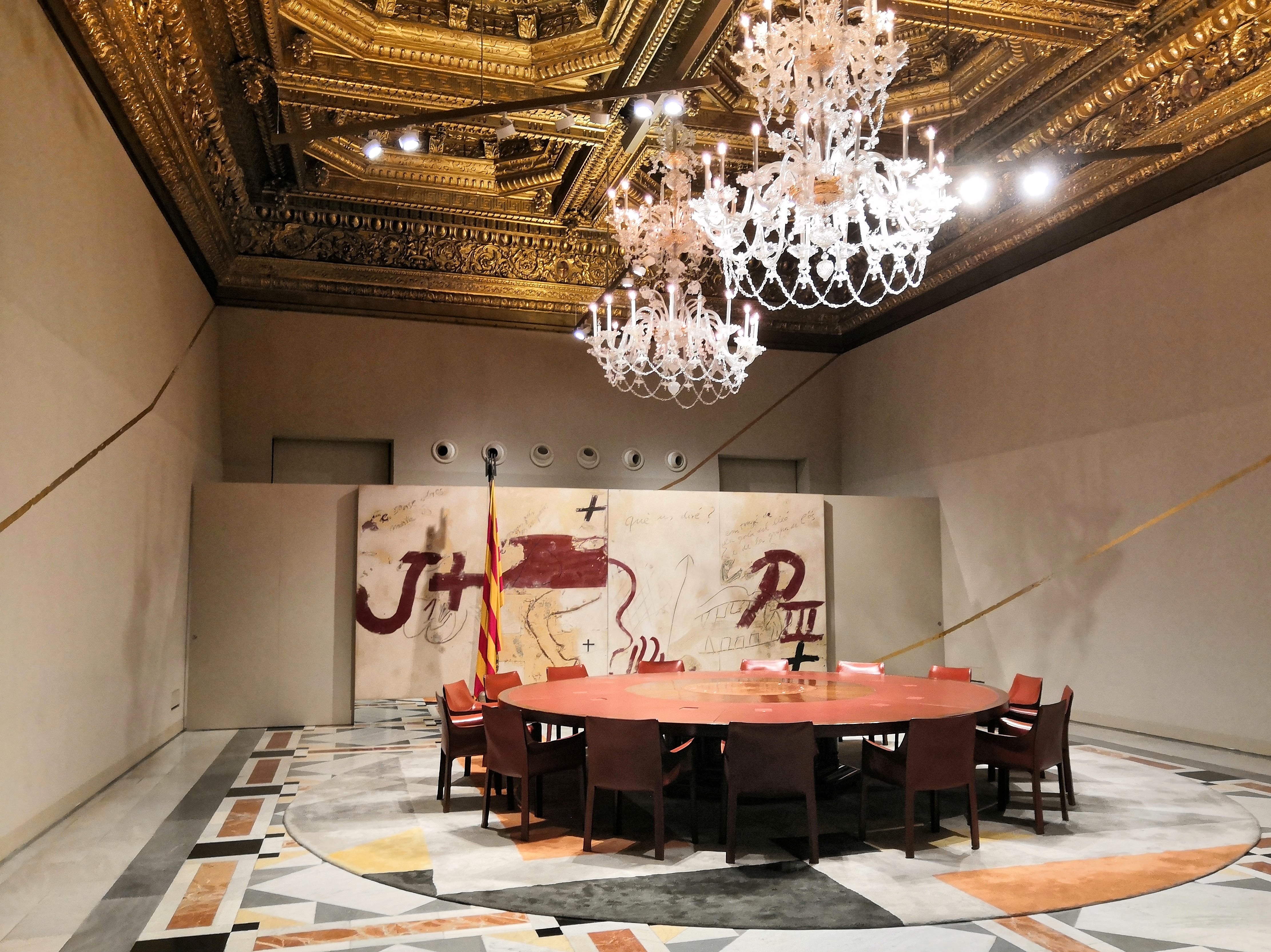|
Castelltallat Range
The Castelltallat range (Catalan: Serra de Castelltallat) is located in central Catalonia (Spain) between the comarcas of Bages and Solsonès, extending over the provinces of Barcelona and Lleida, and occupying an area of about 65 square kilometres. It is one of the isolated hills of the Catalan Central Depression and is located at its southwestern end. Description Geologically the Castelltallat range is made up of limestone and marl mountains oriented WSW-ENE. The highest point of the range is the 936 m high "Tossal". The northern slopes are steep and forested, while the southern slopes are used for agriculture owing to their lesser inclination. Most of the mountain belongs to the municipality of Sant Mateu de Bages while the western part lies within the municipalities of Pinós and La Molsosa. The village of Castelltallat was a municipality until 1840 when it became part of San Mateu de Bages municipal term. The parish church of Sant Miquel has been documented since 1031 and ... [...More Info...] [...Related Items...] OR: [Wikipedia] [Google] [Baidu] |
Bages
Bages () is a comarca (county) in the center of Catalonia, Spain. It includes a ''subcomarca'', Lluçanès. Industries include the mining of potash at Súria and Sallent, and the manufacture of textiles along the rivers Llobregat and Cardener. Agriculture includes vineyards, cereals, and olive groves. To the north are Berguedà and (running clockwise) Osona, Moianès, and Vallès Occidental. To the south are Baix Llobregat, l'Anoia and el Solsonès. In May 2015, Bages lost five municipalities - Calders, L'Estany, Moià, Monistrol de Calders, Santa Maria d'Oló - to the new comarca of Moianès Moianès () is a ''comarca'' in the centre of Catalonia, Spain. It became a comarca in May 2015, following approval in a local referendum and by the Parliament of Catalonia. Its 10 municipalities were in the comarques of Bages, Osona, and Vallès .... Municipalities References External linksOfficial comarcal web site, in Catalan [...More Info...] [...Related Items...] OR: [Wikipedia] [Google] [Baidu] |
Renaissance
The Renaissance ( , ) , from , with the same meanings. is a period in European history marking the transition from the Middle Ages to modernity and covering the 15th and 16th centuries, characterized by an effort to revive and surpass ideas and achievements of classical antiquity. It occurred after the Crisis of the Late Middle Ages and was associated with great social change. In addition to the standard periodization, proponents of a "long Renaissance" may put its beginning in the 14th century and its end in the 17th century. The traditional view focuses more on the early modern aspects of the Renaissance and argues that it was a break from the past, but many historians today focus more on its medieval aspects and argue that it was an extension of the Middle Ages. However, the beginnings of the period – the early Renaissance of the 15th century and the Italian Proto-Renaissance from around 1250 or 1300 – overlap considerably with the Late Middle Ages, conventionally da ... [...More Info...] [...Related Items...] OR: [Wikipedia] [Google] [Baidu] |
Quercus Ilex
''Quercus ilex'', the evergreen oak, holly oak or holm oak is a large evergreen oak native to the Mediterranean region. It is a member of the ''Ilex'' section of the genus, with acorns that mature in a single summer. Description An evergreen tree of large size, attaining in favourable places a height of , and developing in open situations a huge head of densely leafy branches as much across, the terminal portions of the branches usually pendulous in old trees. The trunk is sometimes over in girth. The young shoots are clothed with a close gray felt. The leaves are very variable in shape, most frequently narrowly oval or ovate-lanceolate, long, 1.2–2.5 cm wide, rounded or broadly tapered at the base, pointed, the margins sometimes entire, sometimes (especially on young trees) more or less remotely toothed. When quite young, both surfaces are clothed with whitish down, which soon falls away entirely from the upper surface leaving it a dark glossy green; on the lower s ... [...More Info...] [...Related Items...] OR: [Wikipedia] [Google] [Baidu] |
Quercus Humilis
''Quercus pubescens'', the downy oak or pubescent oak, is a species of white oak (genus ''Quercus'' sect. ''Quercus'') native to southern Europe and southwest Asia, from northern Spain (Pyrenees) east to the Crimea and the Caucasus. It is also found in France and parts of central Europe. Description ''Quercus pubescens'' is a medium-sized deciduous tree growing up to . Forest-grown trees grow tall, while open-growing trees develop a very broad and irregular crown. They are long-lived, to several hundred years, and eventually grow into very stout trees with trunks up to in diameter. Open-grown trees frequently develop several trunks. The bark is very rough, light gray and divided into small flakes. Large trees develop very thick whitish bark cracked into deep furrows, similar to the pedunculate oak but lighter in colour. The twigs are light purple or whitish, with tomentum. The buds are small () and blunt, light brown. The leaves are leathery usually long (rarely to 13&nbs ... [...More Info...] [...Related Items...] OR: [Wikipedia] [Google] [Baidu] |
Pinus Sylvestris
''Pinus sylvestris'', the Scots pine (UK), Scotch pine (US) or Baltic pine, is a species of tree in the pine family Pinaceae that is native to Eurasia. It can readily be identified by its combination of fairly short, blue-green leaves and orange-red bark. Description ''Pinus sylvestris'' is an evergreen coniferous tree growing up to in height and in trunk diameter when mature, exceptionally over tall and in trunk diameter on very productive sites. The tallest on record is a tree over 210 years old tree growing in Estonia which stands at . The lifespan is normally 150–300 years, with the oldest recorded specimens in Lapland, Northern Finland over 760 years. The bark is thick, flaky and orange-red when young to scaly and gray-brown in maturity, sometimes retaining the former on the upper portion.Trees for LifeSpecies profile: Scots pine/ref> The habit of the mature tree is distinctive due to its long, bare and straight trunk topped by a rounded or flat-topped mass of ... [...More Info...] [...Related Items...] OR: [Wikipedia] [Google] [Baidu] |
Pinus Halepensis
''Pinus halepensis'', commonly known as the Aleppo pine, also known as the Jerusalem pine, is a pine native to the Mediterranean region. Description ''Pinus halepensis'' is a small to medium-sized tree, tall, with a trunk diameter up to , exceptionally up to . The bark is orange-red, thick, and deeply fissured at the base of the trunk, and thin and flaky in the upper crown. The leaves ('needles') are very slender, long, distinctly yellowish green, and produced in pairs (rarely a few in threes). The cones are narrow conic, long and broad at the base when closed, green at first, ripening glossy red-brown when 24 months old. They open slowly over the next few years, a process quickened if they are exposed to heat such as in forest fires. The cones open wide to allow the seeds to disperse. The seeds are long, with a wing, and are wind- dispersed.Nahal, I. (1962). Le Pin d'Alep (''Pinus halepensis'' Miller). Étude taxonomique, phytogéographique, écologique et sylvicole. '' ... [...More Info...] [...Related Items...] OR: [Wikipedia] [Google] [Baidu] |
Pinus Nigra
''Pinus nigra'', the Austrian pine or black pine, is a moderately variable species of pine, occurring across Southern Europe from the Iberian Peninsula to the eastern Mediterranean, on the Anatolian peninsula of Turkey, Corsica and Cyprus, as well as Crimea and in the high mountains of Northwest Africa. Description ''Pinus nigra'' is a large coniferous evergreen tree, growing to high at maturity and spreading to wide. The bark is gray to yellow-brown, and is widely split by flaking fissures into scaly plates, becoming increasingly fissured with age. The leaves ('needles') are thinner and more flexible in western populations. The ovulate and pollen cones appear from May to June. The mature seed cones are (rarely to 11 cm) long, with rounded scales; they ripen from green to pale gray-buff or yellow-buff in September to November, about 18 months after pollination. The seeds are dark gray, long, with a yellow-buff wing long; they are wind-dispersed when the cones open from ... [...More Info...] [...Related Items...] OR: [Wikipedia] [Google] [Baidu] |
Devesa 0010
Devesa is a surname. Notable people with the surname include: * Didac Devesa (born 1990), Spanish footballer * Domènec Ruiz Devesa (born 1978), Spanish politician * Jorge Devesa (born 1988), Spanish footballer * Susan Shaw Devesa (born 1944), American cancer epidemiologist See also * Devesas Factory Warehouse {{surname ... [...More Info...] [...Related Items...] OR: [Wikipedia] [Google] [Baidu] |
Lathyrus Latifolius (pèsol Bord)
''Lathyrus latifolius'', the perennial peavine, perennial pea, broad-leaved everlasting-pea, or just everlasting pea, is a robust, sprawling herbaceous perennial flowering plant in the pea family Fabaceae. It is native to Europe but is present on other continents, such as North America and Australia, where it is most often seen along roadsides.Sierra Nevada Wildflowers, Karen Wiese, 2nd ed, 2013, p. 70 Morphology ''Lathyrus latifolius'' has winged hairless stems, and alternating blue green compound leaves consisting of a single pair of leaflets and a winged petiole about long. The leaflets are narrowly ovate or oblong-ovate, smooth along the margins, hairless and up to long and across. There is a branched tendril between the leaflets. Racemes Short racemes of 4–11 flowers are produced from the axils of the leaves. The flowers, which are unscented, are about across with a typical structure for '' Faboideae'', with an upper standard and lower keel, enclosed by lateral ... [...More Info...] [...Related Items...] OR: [Wikipedia] [Google] [Baidu] |
Government Of Catalonia
The Executive Council of Catalonia ( ca, Consell Executiu) or the Executive Government of Catalonia (Catalan: ) is the Executive (government), executive branch of the Generalitat of Catalonia. It is responsible for the political action, regulation, and administration of the government of the autonomous region. The President of the Generalitat de Catalunya, President of the Generalitat is the head of government. The president may also appoint a List of First Ministers of Catalonia, First Minister (Catalan: ''Conseller(a) primer(a)'') to serve as their deputy, although since 2006 the office has been replaced by that of the List of Vice Presidents of Catalonia, Vice-President of the Generalitat of Catalonia, who must be approved by the Parliament of Catalonia. The various ministers (Catalan: ''consellers'') are also appointed by the President of the Generalitat. Ministers need not be Deputy (Catalonia), deputies in the parliament, as they have an automatic right to intervene in p ... [...More Info...] [...Related Items...] OR: [Wikipedia] [Google] [Baidu] |
Submediterranean Climate
In biogeography, the Mediterranean Basin (; also known as the Mediterranean Region or sometimes Mediterranea) is the region of lands around the Mediterranean Sea that have mostly a Mediterranean climate, with mild to cool, rainy winters and warm to hot, dry summers, which supports characteristic Mediterranean forests, woodlands, and scrub vegetation. Geography The Mediterranean Basin covers portions of three continents: Europe, Africa, and Asia. It is distinct from the drainage basin, which extends much further south and north due to major rivers ending in the Mediterranean Sea, such as the Nile and Rhône. Conversely, the Mediterranean Basin includes regions not in the drainage basin. It has a varied and contrasting topography. The Mediterranean Region offers an ever-changing landscape of high mountains, rocky shores, impenetrable scrub, semi-arid steppes, coastal wetlands, sandy beaches and a myriad islands of various shapes and sizes dotted amidst the clear blue sea. Cont ... [...More Info...] [...Related Items...] OR: [Wikipedia] [Google] [Baidu] |






.png)